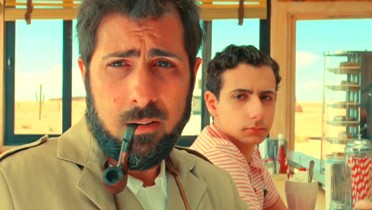 American director Wes Anderson has crafted a film about the fictional process itself, through an elaborate evocation of 1950s America and its science fiction.
American director Wes Anderson has crafted a film about the fictional process itself, through an elaborate evocation of 1950s America and its science fiction.
Wes Anderson has a consistent style. It’s impossible to mistake it for someone else’s. But that doesn’t mean all his films are the same, or are based on the same idea. And in the case of his latest picture, Asteroid City, I think we’re seeing something conceptually different from anything he’s done before.
We begin in black-and-white, with a pompous host (Bryan Cranston) telling us about a great play being written by a great American author, Conrad Earp, played by Edward Norton. It’s a play, but the black-and-white aesthetic seems to place it in the realm of live TV in the 1950s, when interesting original drama by new writers and directors was regularly aired on the still-young television networks. This particular play is set in 1955, in a small tourist attraction in the middle of nowhere, with desert as far as the eye can see, called Asteroid City. An asteroid fell there some time ago, and this clump of buildings (you could hardly call it a town, much less a city) has built up around it. And the camera helps us out at one point by doing a complete 360 so we can see it all.
Jason Schwartzman plays Augie Steenbeck, who is taking his kids to see their grandfather when the car breaks down in Asteroid City. He’s put off telling them that their mother has just died, and is forced to do so now in the most awkward way possible, showing them the Tupperware containing her ashes. It so happens that there is a junior astronomy fair and contest scheduled for that weekend in Asteroid City, and Augie’s gifted son Woodrow is interested in participating. Here is the occasion for the entrance of a whole bunch of characters connected with the event, including a moody, enigmatic woman played by Scarlet Johansson, who forges an ambiguous bond with Schwartzman’s character. There are characters played by Tom Hanks, Liev Schreiber, Steve Carrell, and many others. The junior astronomy event itself is interrupted by an alien emerging from a descending space ship, in a neat evocation of 1950s science fiction.
So here I’ve described what sounds like a plot. But watching the film, it becomes evident that the story is actually very abstract, extremely loose-fitting, like a game where you play with certain elements in different ways, just for the fun. Anderson has pulled the narrative thread out, and left us with an amusing and intriguing series of symbols of American beliefs and illusions. And then from time to time we return to the framing device in black-and-white, by which we are reminded that this is just fiction. Anderson’s subject is fiction itself, the act of playing with fictional characters doing fictional things. Here he celebrates the delight, puzzlement, and essential artificiality of the whole enterprise.
What cracks me up, I have to admit, is that because of Wes Anderson’s unique, well-known style, and his ability to load his films with lots of famous actors, he’s managed to launch what is basically an avant-garde art film into the cinematic mainstream, while laughing at his own audacity. Late in the film, a few of the actors start complaining that they don’t understand the play. Anderson might be trying to speak for the audience here. The odd and insistent phrase (and song) “you can’t wake up if you don’t fall asleep” is as straightforward as Anderson will ever get. For artists to create, they need to first turn off their conventional ideas of reality. Or so it seems to me, but I do believe I need to watch Asteroid City again.

George Segal plays an American corporal whose wheeling and dealing makes him a kind of king within the narrow world of a Japanese prisoner...

Hollywood loved making comedies about divorce, and Leo McCarey’s 1937 film, starring Cary Grant and Irene Dunne, was the best of the bunch. Recently...

Frank Borzage’s 1927 romance was a major success and reflected a popular sense of spiritual loss still evoked by the First World War. If...